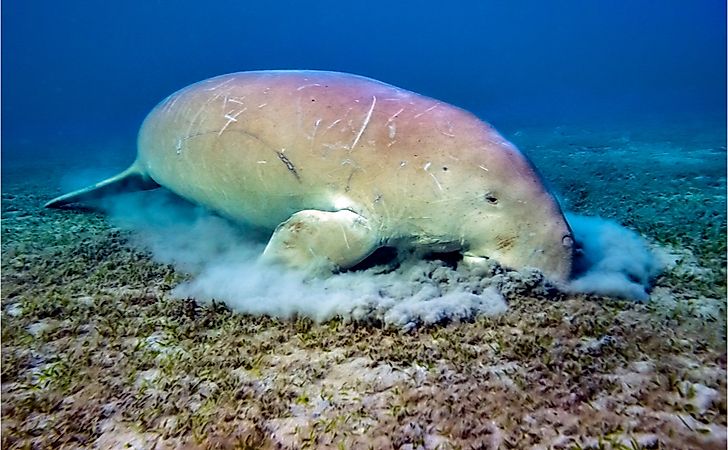What Do Dugongs Eat?

Description Of The Dugong
The dugong (Dugong dugon)is a herbivorous marine mammal, the only extant species of the Dungongidae family. The species belongs to the same order as the manatee, which is one of its closest relatives, but the body of a dugong is streamlined, torpedo-shaped, and can be differentiated by the shape of its tail. The dugong features a roughly triangular tail, similar to that of a dolphin, while manatees have large rounded tails. They grow to between 7 and 11 ft in length and can weigh between 500 and 925 lbs.
The dugong has a thick, smooth, and tough skin. Newborn dugongs have a pale cream skin that darkens with age, eventually turning a deep slate gray on the dorsum and sides. Dugongs have hair that sparsely covers their bodies, while their muzzles have bristles. They develop tusks that become visible in adult males. The snout of a dugong is rounded and large, while its upper lip is muscular and cleft, hangs over its mouth, and curves downward. Dugongs are similar in appearance to whales, but their evolutionary path is independent. The species is sometimes referred to as a "sea cow" because it grazes on seagrass, although it believed to be more closely related to elephants than cows.
What Do Dugongs Eat?
Dugongs are strict herbivores that feed on seagrass, especially the Hydrocharitaceae and Potamogetonaceae family of seagrasses. They prefer seagrasses that are low in fiber content, high in nitrogen, and easily digestible. Their intestines are long and suitable for digesting seagrass, and their metabolism rate is low. When seagrass is scarce, dugongs feed on algae. There has been speculation that dugongs occasionally eat invertebrates such as sea squirts, shellfish, and polychaete worms, which live in the seagrass. Dugongs rip up the entire seagrass plant using their upper lip, which is flexible, and when they graze, they leave unique furrows on the seagrass bed that are visible from the surface.
Distribution Of Dugongs
Dugongs inhabit the warm coastal waters of the Pacific and Indian Oceans. Australia is home to the largest dugong population, but the species is also common in the Persian Gulf, Red Sea, the eastern coast of Africa, and the western coast of Madagascar. Other dugong populations can be found around parts of the Indian subcontinent and western regions of the Pacific, from northern Australia to Okinawa, Japan. Isolated populations also exist in the Pacific archipelago of Palau.
Behavior Of Dugongs
Dugongs are social animals and are typically observed in groups ranging between 2 and 200 individuals. A mother and her calf is usually the smallest group. Herds of up to 200 dugongs have been observed, but are rare because seagrasses cannot support large herds for an extended period. They are semi-nomadic animals and often migrate long distances in search of seagrass. However, some could inhabit a single range for the majority of their lives. The quality and quantity of seagrass drive dugong migration, as they move to a new seagrass bed once one is exhausted. Dugongs always inhabit turbid water, which makes observation difficult without disturbance.











